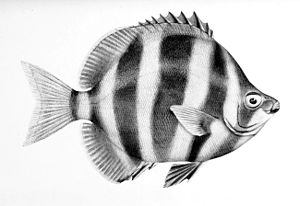Six-band stone bream
| Six-band stone bream | ||||||||||||
|---|---|---|---|---|---|---|---|---|---|---|---|---|

Six-band stone bream ( Tilodon sexfasciatus ) |
||||||||||||
| Systematics | ||||||||||||
|
||||||||||||
| Scientific name of the genus | ||||||||||||
| Tilodon | ||||||||||||
| Thominot , 1881 | ||||||||||||
| Scientific name of the species | ||||||||||||
| Tilodon sexfasciatus | ||||||||||||
| ( Richardson , 1842) |
The six-band stone bream or six-band butterfly fish ( Tilodon sexfasciatus , syn . : Chaetodon sexfasciatus , C. ocellipinnis , Tilodon australis , T. sexfasciatum , Vinculum sexfasciatus ), called moonlighter in Australia , is a marine fish that occurs on the coast of South Australia and Tasmania .
features
The high-backed, up to 40 centimeters long fish resemble the butterfly fish of the genus Chelmon from the tropical Indo-Pacific. They have a whitish base color and show six vertical dark bands on the sides. Young fish are more pointed-headed than adult fish and have a black, yellow-rimmed eye spot on each of the soft-radiated parts of the dorsal and anal fin .
- Fin formula : Dorsal X / 20–21, Anale III / 17–19.
Way of life
The six-band stone bream lives in pairs, as solitary animals or in small groups on rocky, algae-covered reefs at depths of 5 to 30 meters and feeds primarily on algae, but also on small invertebrates. Young fish are more likely to be found in shallow, protected bays, while adults are more likely to be found in greater depths.
Systematics
The species was by the Scottish naturalist 1842 John Richardson as Chaetodon sexfasciatus described and by 1881 Alexander Thominot in the monotypic genus Tilodon asked.
literature
- Hans A. Baensch / Robert A. Patzner: Mergus Sea Water Atlas Volume 7 Perciformes (perch-like) , Mergus-Verlag, Melle, ISBN 3-88244-107-0 .
- Helmut Debelius / Rudie H. Kuiter : Butterfly fish, Chaetodon . Ulmer Verlag, 2003, ISBN 3-8001-4243-0 .
Web links
- Six-band stone bream on Fishbase.org (English)